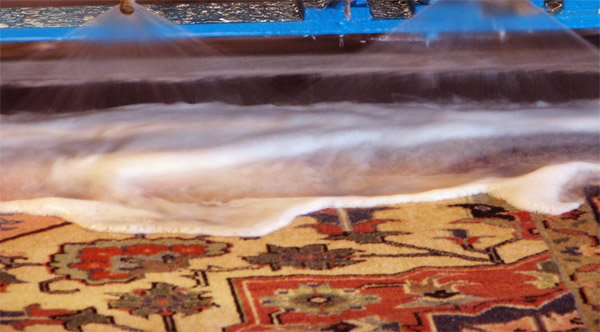Advanced Carpet’s Experienced Technicians Understand the Intricacies of Oriental Rug Cleaning
Oriental rugs are an exotic and sophisticated touch to any living space. The task of Oriental rug cleaning can be nearly as intricate as the designs on the rugs themselves. Even though they are called Oriental rugs they are actually meticulously woven in various places in the Middle East, Turkey, India, and also Southeast Asia. All true Oriental rugs are hand-knotted. Hand-knotting is a highly skilled process where artisans tie individual knots onto a framework of interwoven threads. The pile and the pattern of the rug is created by the variation of these knots, in coordination with their color and location.
A majority of hand-knotted rugs have a woolen pile, but this pile can have many combinations of animal and hair fibers. The shapes and swirls of oriental rugs are quite often cotton, but finer pieces use a silk foundation, and many antique pieces have a wool or silk foundation. In addition to basic sheep’s wool, goat hair, camel hair, mohair, silk, and even some metal fibers can bey found in many rugs. Knowing these details is important to get the best results when cleaning Oriental rugs.
Maintaining your rug through proper cleaning and care is the key to a long life
Even though Oriental rugs are handwoven the same way they were hundreds of years ago, the rug that is produced has many technical variables that must be considered before cleaning. Our expert staff of Oriental rug cleaning technicians inspects each rug to determine its country of origin, the type of pile, the type of weave, what foundation material was used, the dyes used, and the overall condition of the rug before we begin any cleaning. Our technicians are trained and certified by IICRC and have years of real world experience with fine rugs and carpets.
Vacuuming regularly is the most basic step in Oriental rug cleaning. Moving the vacuum in the direction of the rug’s pile helps to prevent excess dirt and dust from falling deeper into the pile. Going against the direction of the pile or sideways will have the effect of brushing and lifting the rug pile. You should vacuum in at least two directions, starting with the direction of the pile. Be careful how often you vacuum the fringe as it is often damaged by vacuuming. This happens most often if your vacuum has a brush or beater bar. When you do need to clean the fringes use suction only.
Even with vacuuming you will need to periodically call for professional Oriental rug cleaning. Fine Oriental rugs need specialized hand washing and drying techniques because the natural fibers in these rugs do not respond well to harsh chemicals. Hot steam extraction and other methods that are used for wall to wall carpets is also not recommended. Home carpeting today is commonly made with synthetic materials like nylon, rayon or polyester blends. These materials are made to resist the absorption of dirt and stains and dirt tends to lay on the fibers’ surface. Oriental rug cleaning is different. Fine Oriental rugs with natural fibers such as wool and cashmere absorb much more water. This makes it so the chemicals used in cleaning wall to wall carpet are absorbed into the natural fibers and aren’t easily removed.




